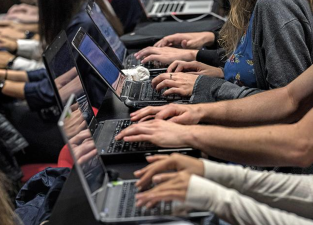"The students in the classroom have not finished their classes yet, but the campus has disappeared." This joke in the past is now gradually becoming a reality.


"The students in the classroom have not finished their classes yet, but the campus has disappeared." This joke in the past is now gradually becoming a reality.
In April, two century-old prestigious schools in the United States, Wells College and the University of the Arts in Philadelphia, announced their closures one after another.
The closure of colleges and universities is mainly due to three factors: the continued decline in undergraduate enrollment, the intensification of inflation shocks, and the general skepticism of society towards higher education.
Although the school has proposed a plan to transfer freshmen to nearby partner schools, this move still triggered a joint boycott by all teachers and students.
Last year, the American higher education community experienced an unprecedented crisis: 30 universities closed one after another in just one year. This phenomenon is not limited to two well-known institutions, but has affected the entire education system.

The successive closures of higher education institutions have aroused social concern. As a key position for talent training, the survival of these educational institutions is facing severe tests.
As an important place where many families place their educational expectations, will higher education institutions face the fate of extinction?
According to the latest research from Harvard Business School, many American universities will encounter serious financial difficulties in the next 15 years, and some institutions may even be forced to close.
Through data analysis, the American EAB Education Consulting Company found that:
By 2030, nearly 450 colleges and universities may face a quarter reduction in the number of students.
It is predicted that by 2030, the number of colleges and universities facing a reduction in student resources will climb to 566, of which nearly 247 colleges and universities may reduce the number of freshmen by more than half.
The continued shrinking of college enrollment will inevitably lead to the closure of some colleges and universities due to insufficient student resources.
Globally, many developed countries including Japan, South Korea and the United Kingdom have successively closed higher education institutions. This wave of change in the education sector is continuing to ferment and its impact is expanding.
In 2021, South Korea's higher education faces severe challenges. Among the nearly 200 four-year colleges and universities, more than 160 have failed to complete their enrollment plans. It is worth noting that more than 90% of the colleges and universities with insufficient enrollment are local universities. Among them, Xihai University and Dongpusan University submitted applications for closure in the same year due to student source problems.
South Korean media revealed that in the 2023 national college unified enrollment, 26 majors are facing the embarrassing situation of no one interested in, involving 14 colleges and universities.
Japan has also encountered a similar dilemma.
At the end of 2023, 12 Japanese higher education institutions, including Nara Sawa Junior College and Fukuoka Jogakuin Junior College, have suspended the admission of new students.
It is expected that by 2050, the enrollment scale of Japanese higher education institutions will be reduced to 490,000, a decrease of more than 100,000 students compared with the current level. This trend indicates that Japanese colleges and universities will fall into a more severe survival test, and some colleges and universities may face the risk of elimination.
The reduction in the scale of college enrollment is directly related to the continued decline in fertility levels.

In the 1970s, South Korea ushered in a peak period of population birth, with the annual number of new babies exceeding the one million mark.
1980 witnessed a continuous decline in the number of newborns, and the number of births that year fell below the 900,000 mark.
Data from 2020 showed that the relevant figures in South Korea have dropped sharply to 200,000, ranking last among 197 countries in the world.
The problem of funding shortage is plaguing many universities, and its main root cause is the decline in income caused by the shrinking student population.
Queen's University, a top university in Canada with a long history and a well-known institution founded 183 years ago, issued a warning in January 2023. As the alma mater of Elon Musk, the school said that if it does not take immediate austerity measures, its financial reserves will be exhausted between 2025 and 2026, and the school will face the crisis of closure.
Even top universities are facing such a dilemma, and the situation of ordinary universities is naturally more pessimistic.
The list of closed universities recently announced shows that these institutions are generally newly established private institutions with limited student numbers.
These educational institutions mainly rely on collecting student fees or accepting social donations to maintain daily operations.
The continuous shrinking of student population has doubled the operating pressure of schools, and the education level has declined accordingly.
The latest survey data from authoritative American institutions show that more than 40% of respondents reported that colleges and universities failed to cultivate students' independent thinking ability, and another 37% pointed out that higher education lacks practical skills, resulting in limited promotion of degrees to employment.
According to the Wall Street Journal, a graduate of a private liberal arts college is in dire financial straits. Due to the sluggish job market, the young woman failed to get a job opportunity after completing her studies, which made it difficult for her to repay her student loans of up to $85,000.
The traditional education system relies too much on outdated textbooks and theoretical topics, which are often out of touch with social needs and have limited practical value. This teaching method has caused a split between theory and application, forcing graduates to re-master the skills needed for actual work.
Rather than improving graduates' competitiveness in the workplace, higher education qualifications have left some students burdened with heavy debt pressure.


